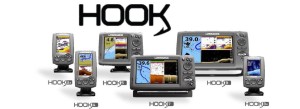The HOOK series features HOOK 9, HOOK 7, HOOK 5 and HOOK 4 standalone displays that combine CHIRP Sonar with DownScan ImagingT technology, a super bright, LED backlit display, built in GPS antenna and a wide range of high definition mapping opt ions. The HOOK family also includes the HOOK 3 series, featuring bright color displays with Broadband SounderT or DownScan ImagingT. CHIRP Sonar Advantage Easier to identify and distinguish bait and game fish targets • Better target identification at greater depths Mark fish clearly at faster boat speeds Exclusive HOOK CHIRP Advantages No other standalone fish finder has integrated CHIRP sonar No other standalone fish finder offers fish revealing DownScan Overlay Multiple CHIRP frequency options from a single transducer CHIRP sonar performance with the Lowrance HDI SkimmerY TrackBackT sonar history Simple to Use Intuitive page selection Simple menu selections On screen sonar adjustments Quick release, tilt swivel bracket with optional RAMY mount integration Best Mapping Insight GenesisT Insight PRO Navionics C MAP Elite CHIRP End of Life With the announcement of the new HOOK series all Elite CHIRP series models are being discontinued
Elite CHIRP inventory is available while supplies last, on a first come, first served basis, and must be delivered in 2015. If the Elite CHIRP model you want to order is not available, you can place an order for a new HOOK series unit with shipments beginning in December 2015
Lowrance is announcing a new family of fish finders/chart plotters 式 The Elite Ti series, featuring 7 and 5 inch touchscreen displays. The Elite Ti series combines high end features with powerful performance at an affordable price.
The Elite Ti series features 7 and 5 inch standalone displays that include a touchscreen, easy to use interface, CHIRP Sonar, StructureScanY HD SideScan and DownScan ImagingT, built in GPS antenna and a wide range of high definition mapping options. Elite Ti models support Low/Mid/High CHIRP and 50/83/200/455/800kHz frequencies.
Integrated wireless connectivity allows boaters to not only download software updates directly to the unit, but also gives them the capability to download Insight Genesis custom maps Directly to the chartplotter 式 for immediate use. The Elite Ti series is scheduled to start shipping in February 2016. Elite Ti Feature Summary: High resolution touch display LED backlit color display with touchscreen interface provides fast, fingertip access to all Elite Ti features CHIRP Sonar, StructureScanY HD and DownScan ImagingT CHIRP Sonar offers improved fish target separation and screen clarity, while the StructureScanY HD sonar imaging system with exclusive Lowrance DownScan ImagingT delivers photo like images of fish holding structure on both sides and directly beneath your boat. StructureScan HD requires optional TotalScanT transducer. TrackBackT Rewind your CHIRP sonar, SideScan or DownScan Imaging history to review structure or fish targets and mark the location with a waypoint. Internal GPS antenna Highly accurate, built in GPS antenna plus a detailed U.S. map Optional chart upgrades Optional Americas chart upgrades include Lake InsightT and Nautic InsightT PRO and HD, Navionics HotMapsY Premium and Fishing HotspotsY PRO. Global chart upgrade options include Navionics + and Jeppesen C MAP MAX N and MAX N+. Built in wireless connectivity Provides access to the GoFree Cloud where you can shop, purchase, download and immediately use Insight maps, and third party maps from GoFree partners MicroSD card slot Quick Release bracket













